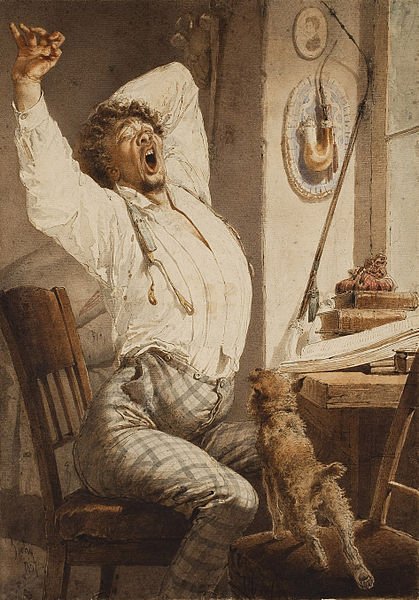The Thick and Thin of Copyright Protection
Copyright lawyers love tell you that copyright law is all about encouraging creativity because that makes it seem that we’re performing some sort of socially useful activity. We love to point to paintings, novels, movies and music. Without the legal monopoly that copyright law confers on “creators,” these wonderful things wouldn’t be created. Or, at least, they wouldn’t be as good.
And—you know what?—sometimes this is even true! There are lots of cases about music and movies and even dancing!
But you know what else is protected by copyright law? A catalogue of dental procedures. Lists of collectable cards. Medical education brochures (e.g., Gastroesophageal Reflux Disease: Understanding Your Health.) Private placement memoranda.
What’s a private placement memorandum? So glad you asked. Before you can ask folks to give your enterprise money, you need to provide them with certain information so they can make an informed decision. If you’re providing this information because you’re offering to sell equity or debt, and the transaction is “private,” then you’ll be expected to provide a “private placement memorandum” (or “PPM”). PPMs are not “creative,” in the usual sense of the word. They are designed to inform. Much of the information you have to provide is required by securities regulations. Even more is required to satisfy experienced investors, who will expect certain information. Further, experienced investors will expect the PPM to follow a set format, because they are busy and will want to locate information important to them quickly. As you’d expect, there are lots of templates for PPMs available on the Web. Here are a few. Here’s a real one.
Copyright Law Is All About Creativity (for a Certain Value of “Creative”).
The truth is that copyright law really does protect just creative works—for a certain value of “creative.” More precisely, copyright protects works that are original, which means only that they are the product of a human mind1No monkeys, please., plus at least the slightest flash of imagination. To simplify greatly, so long as there is some reasonable choice in how you express something, it’s original and thus eligible for copyright protection.
An ordinary phone book isn’t original because, in organizing pre-existing factual information alphabetically, there’s no imaginative spark. The method of organization is determined by an outside structure that you’re simply imposing on the information. But—you could organize the same pre-existing factual information in some interesting, creative way. Perhaps you organize it based on what names you think are prettiest or “most metal.” Of course, it wouldn’t be very useful anymore, but that’s kind of the trade off: usually, the more creative, the less useful, and vice versa. If you organized the names by profession, for example, your phone book wouldn’t be original because that’s just another standard way to organize this sort of information.2In the old days, this was known as “The Yellow Pages.” If you organized in order of the length of each person’s last name, that also wouldn’t be original, though it also wouldn’t be very useful, either!3Congratulations on that! And if you didn’t organize the information at all but just randomized it, that also wouldn’t be original because the final result would be completely out of your hands.
Let us return to the exciting example of the private placement memo. It’s going to be mostly factual information—like a phone book—but there are multiple meaningful ways to present that information, despite the regulatory and normative constraints. The bar for originality is very low, indeed.
An Actual Fight Over a Private Placement Memo
Of course, I wouldn’t be talking about private placement memos in a blog dedicated to intellectual property if there wasn’t an actual case in which someone was asserting copyright in some private placement memos. Because of course there is. The plaintiff owns and operates properties—very specific types of properties4Those leased to the U.S. General Services Administration.—which it finances through bonds that are specific to the type of property in which plaintiff deals. In offering its bonds for sale, the plaintiff has to provide potential investors with private placement memos, which are themselves specific to the type of bond being offered.
The defendant was5I’ll be they aren’t any longer! the plaintiff’s investment banker. Among other things, the defendant helped the plaintiff prepare and issue the private placement memos. Defendant was also the investment banker for a couple of the plaintiff’s direct competitors, i.e., they dealt in the same type of property plaintiff did. Plaintiff got ahold of these competitors’ private placement memos and felt that they were too similar to the plaintiff’s to be coincidental. Plaintiff sued the competitors for copyright infringement, and in the course of doing so, discovered the source of the competitors’ private placement memos: the defendant investment bank. This fairly very grudge-y lawsuit followed.
The lawsuit is still in the “pleading” stage, i.e., where the parties are just fighting about each other’s accusations and allegations, not about evidence and proof. The parties are clearly very angry at each other, and they both have a lot of money, so these issues are getting aired out to an unusual degree. The court has issued two separate opinions on each side’s attempts to dismiss the other’s claims (here are the decisions on the defendant’s motion to dismiss some of plaintiff’s claims and the plaintiff’s motion to dismiss the counterclaims). The defendant did not seek to dismiss the copyright claims at this stage. It’s too early for that, and the effort would surely have been wasted. Because the plaintiff registered the private placement memos at issue timely6I.e., within five years of “publication.”, there is a presumption that the memos are original. That shifts the burden to the defendants to prove that the memos aren’t original, and that normally requires proof above and beyond what’s in the pleadings.
Also, the memos probably are original. It doesn’t take much, remember? The memos are probably mostly dictated by unoriginal elements such as facts, regulations and norms, but not entirely. Surely, there is room somewhere for originality. Just please don’t make me find it.7Unless you are one of the parties and are willing to pay me my customary rate.

Listen, don’t try to read the private placement memos unless you’ve had the special training. This young man has yet to complete his training.
But PPMs Aren’t Harry Potter, Either.
But this is not to say that boring works like private placement memos will be treated the same as highly imaginative works. A mostly unoriginal work might still be original, in the same way that a mostly dead hero is still slightly alive, but in the absence of a chocolate-covered magic pill, it can be hard to enforce mostly unoriginal works. That’s because, to infringe the copyright in a work, you have to infringe protectable elements of the work. You are free to mine works for factual information, for example, even if researching and presenting the factual information took a lot of effort.
Courts describe the copyright protection of mostly unoriginal works as “thin.” To infringe such copyrights, courts require a much greater showing of similarity between the two works. In extreme cases, courts will require “literal” copying, e.g., word-for-word identity.
Since a lot of copyright infringement is literal or near-literal copying, thin copyrights still have value, just not as much as “thick” copyrights. If the defendant investment bank copied those private placement memos word-for-word, just substituting different facts where necessary, then the investment bank is in trouble. How much trouble is an interesting question. “Thin” copyright also implies less value. The plaintiff appears to have registered the memos too late to be eligible for statutory damages, and the actual damages cannot be very much. Even if the defendant investment bank used the infringing memos to secure the investments for the plaintiff’s competitors and received a commission for that, it’s going to be difficult to prove that protectable elements of the memos contributed meaningfully to the commission. Most investors, I’m guessing, would testify that they are persuaded by (non-protectable) facts in the memos, rather than by any creative elements. The other most common type of actual damages, lost licensing fees, also seems a non-starter, unless there’s some kind of market for highly specialized PPMs. All things considered, I’d put the damages at roughly the cost of creating the PPMs from scratch (which won’t be much).
It’s Hard to Contribute Creatively to Something That’s Hardly Creative at All.
The defendant investment bank had an interesting push back to the claim of copyright infringement. It argued that it was a co-author of the memos. After all, it helped the plaintiff prepare them. A finding of co-authorship would kill the infringement claim. Co-authors can do what they like with their creations. They don’t need the permission of the other co-authors to make copies, sell copies, and license the works, though they do have an obligation to split profits proportionally.
This is a great strategy, except that, for it to work, the defendant would have to tell the court what it contributed to the memos. Just helping isn’t enough. It’s not even enough to give valuable advice or make suggestions. The defendant had to identify contributions to the memos, and show that those contributions would be copyrightable by themselves.8This last requirement is controversial, and not all courts and scholars agree. In its counterclaim, the defendant was noticeably coy about providing this information. Fatally so. The court found—on the pleadings—that defendant was not a co-author. Given the caliber of the lawyers involved, it’s safe to say that, if defendant really had made a legally-recognizable contribution to the memos, defendant would have adequately detailed it in its pleadings.
There Can Only Be One (Claim).
But, hey, copyright law might giveth, but it also taketh away. The plaintiff also brought a claim against the defendant investment bank for professional negligence, based on the bank’s use of those memos. The court kicked out that claim, though, because it essentially duplicates the copyright claim. (This is known as preemption.) In the realm of copyright, there can only be one (claim)! You can’t repackage your copyright claim as something else and make another claim out of it.
Remember that copyright law can spice up any old document, and thanks for reading!
Footnotes
| ↑1 | No monkeys, please. |
|---|---|
| ↑2 | In the old days, this was known as “The Yellow Pages.” |
| ↑3 | Congratulations on that! |
| ↑4 | Those leased to the U.S. General Services Administration. |
| ↑5 | I’ll be they aren’t any longer! |
| ↑6 | I.e., within five years of “publication.” |
| ↑7 | Unless you are one of the parties and are willing to pay me my customary rate. |
| ↑8 | This last requirement is controversial, and not all courts and scholars agree. |



Rick,
Nice work with this issue as usual.
In case you missed it, and in case you can use it for a future issue, I wanted to alert you to an odd/entertaining copyright case. Of all things, a damn monkey stole a photographer’s camera and took some selfies. The camera was retrieved and photos were posted online. The photos went viral and the photographer (who didn’t take the photos) sued for copyright infringement.
https://www.lexology.com/library/detail.aspx?g=fc9a4901-1a4c-4d96-9189-7cb81d35a252&utm_source=Lexology+Daily+Newsfeed&utm_medium=HTML+email+-+Body+-+General+section&utm_campaign=ACC+Newsstand+subscriber+daily+feed&utm_content=Lexology+Daily+Newsfeed+2017-09-05&utm_term=
Regardless, I hope you are weathering the tempests of 2017.